SRAM Maven Brakes
Stated Weights:
(Includes 1800 mm hose and pads; does not include rotor, hardware, pad spacer, or bar clamps)
- Maven Bronze: 369 g
- Maven Silver: 371 g
- Maven Ultimate: 362 g
MSRP:
- Maven Bronze: $185
- Maven Silver: $265
- Maven Ultimate: $300
- Maven Ultimate Expert Kit: $599
Blister’s Measured Weight per Brake: 365 and 387 g
(Maven Ultimate; includes uncut hoses & bar clamps)
Bolted to: Chromag Lowdown, Rocky Mountain Altitude
Reviewer: 6’, 170 lbs / 183 cm, 77.1 kg
Test Locations: Washington, British Columbia
Test Duration: 6 months
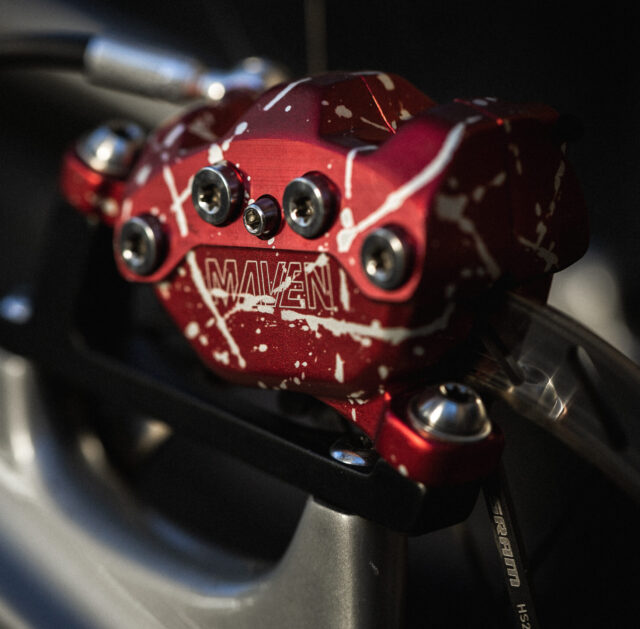
Intro
SRAM’s longstanding Code brakes are some of the most popular options out there. While they work well, a lot of more powerful alternatives have emerged in recent years, and the Codes are now well short of the most aggressive gravity-oriented brakes out there in terms of stopping power.
At the same time, the demands being placed on mountain bike brakes have only grown. Big 29’’ wheels are now commonplace on Enduro and DH bikes, hefty eMTBs are everywhere, and folks are riding faster and harder than ever.
SRAM recognized the need for a bigger, more powerful option at the top of their brake lineup, and the new Maven is the result. The most eye-catching stat with the Maven is that SRAM says it offers 50% (!!!) more power than the Code — while retaining the latter’s lever feel — but that’s just the start.
Design
The lever assembly on the new Maven brakes looks a whole lot like a scaled-up version of the new Stealth version of SRAM’s Code brakes, but there are a lot of more subtle differences when you look closer.
Let’s start with the similarities: the Maven lever is a flip-flop design and can be run on either side of the bar by reversing the Matchmaker X clamp that it bolts to. Those clamps carry over unchanged from the Code to the Maven, and the reach adjuster and contact point adjuster (on models that come with one; see below) look and feel pretty much the same, too.
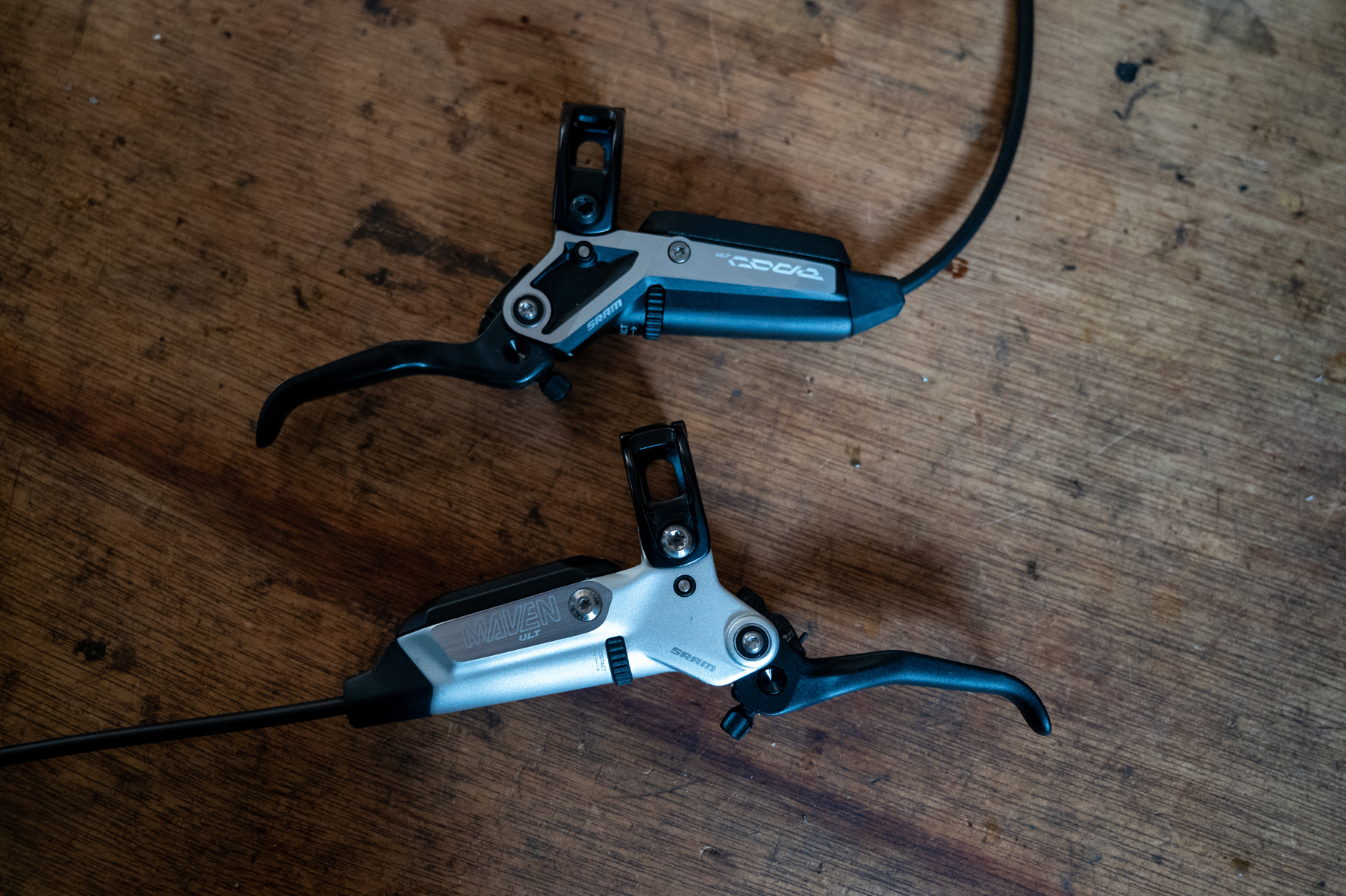
Like the Code Stealth brakes, the Maven levers also tuck the reservoir in close to the bar, but the Maven’s hose exits parallel to the bar (rather than angled in toward it, as with the Codes). As a result, the routing looks cleaner and there should hopefully be less rattling of the brake hoses against the handlebar there.
The Maven lever blade has a nearly identical shape to that of the Code lever, too, though some subtle differences in the placement of the main pivot mean that the lever blades aren’t cross-compatible.
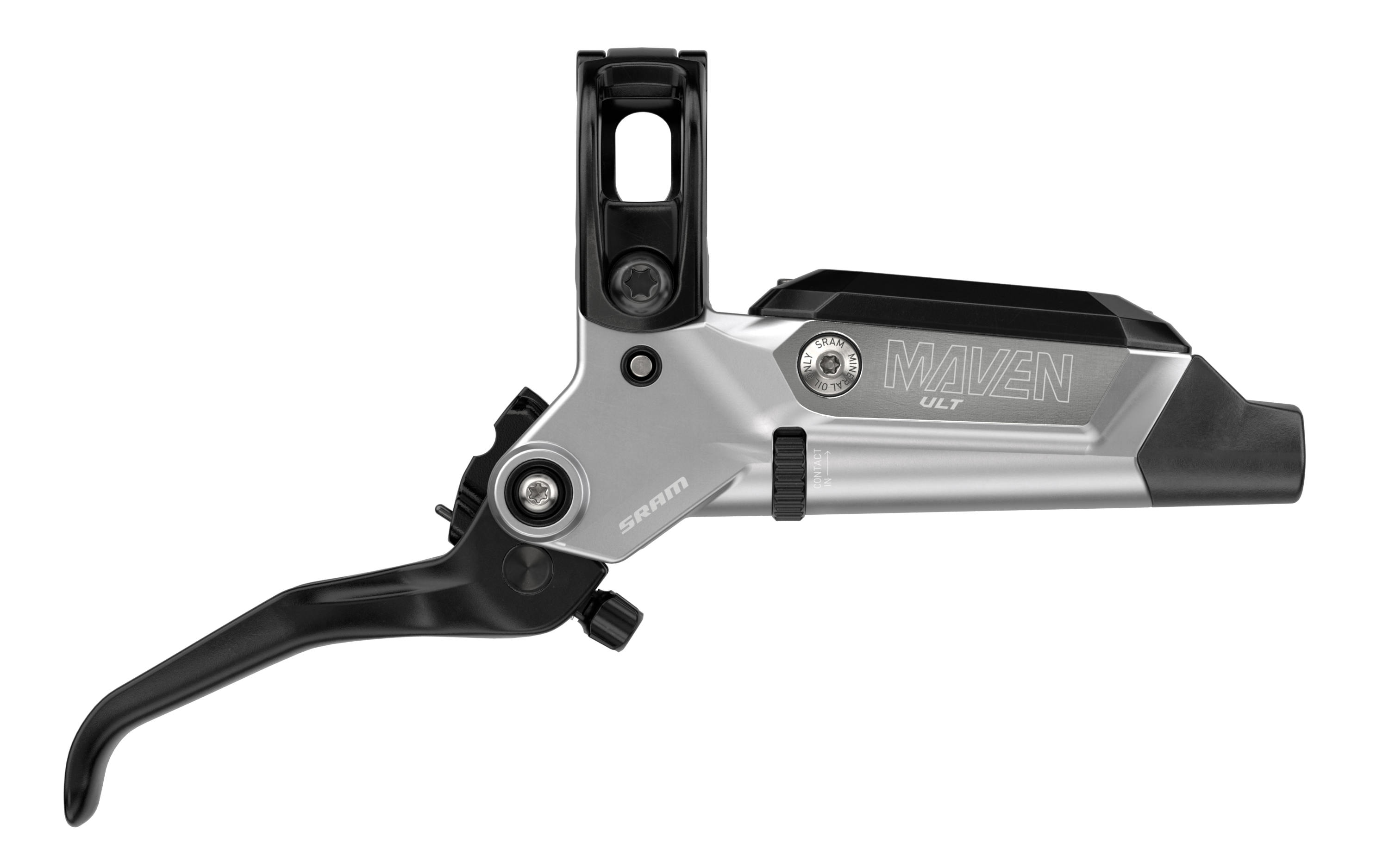
Mineral Oil Fluid
Internally, we find some more differences. The Maven uses mineral oil instead of DOT fluid, and its lever assembly gets different-looking bleed port fittings to help keep the two straight. SRAM makes it very clear that you shouldn’t use the same bleed kit for both types of brakes to avoid introducing the wrong fluid type and damaging the internal seals, and they insist on using their own oil, sourced from Maxima. Unlike DOT fluid, which has a defined chemical composition, stuff branded as “mineral oil” can vary quite a bit and feature a range of different additives that may be detrimental to a given seal material, so SRAM says to play it safe on that front.
The Maven’s switch to mineral oil does mean that SRAM has extended the recommended service interval for flushing the system with new fluid. Since mineral oil doesn’t absorb moisture from the atmosphere the way that DOT fluid does, SRAM says you can go two years on the Maven’s mineral oil (instead of one year on their DOT brakes, including Codes) before giving them a refresh.
Maven Calipers
Things get a lot more obviously different at the caliper end of these brakes. The Maven uses a four-piston caliper with two 18 mm pistons and two 19.5 mm ones — a massive increase in size compared to the Codes, which use two 15 mm pistons and two 16 mm ones. (~3 mm of diameter might not sound like a huge difference, but it adds up to ~46% more total area) As per usual for SRAM, the Maven uses a two-piece caliper but now with four bolts to hold the halves together instead of the usual two, which SRAM says helps stiffen up the caliper for better lever feel.
The Maven caliper body is much, much bigger than the Code one, and SRAM has deliberately bulked it up to help with heat management, in addition to simply making room for the big pistons. They argue that, by adding a bunch of mass to the caliper, it’ll both be harder to wildly overheat, and also retain some heat once it gets up to temperature, and help keep the brake within its ideal operating temperature range. Overheating a brake is, of course, detrimental to its performance, but super cold brakes don’t work optimally, either, and SRAM says that the bulky Maven caliper helps mitigate those temperature swings in both directions and makes for more consistent performance.
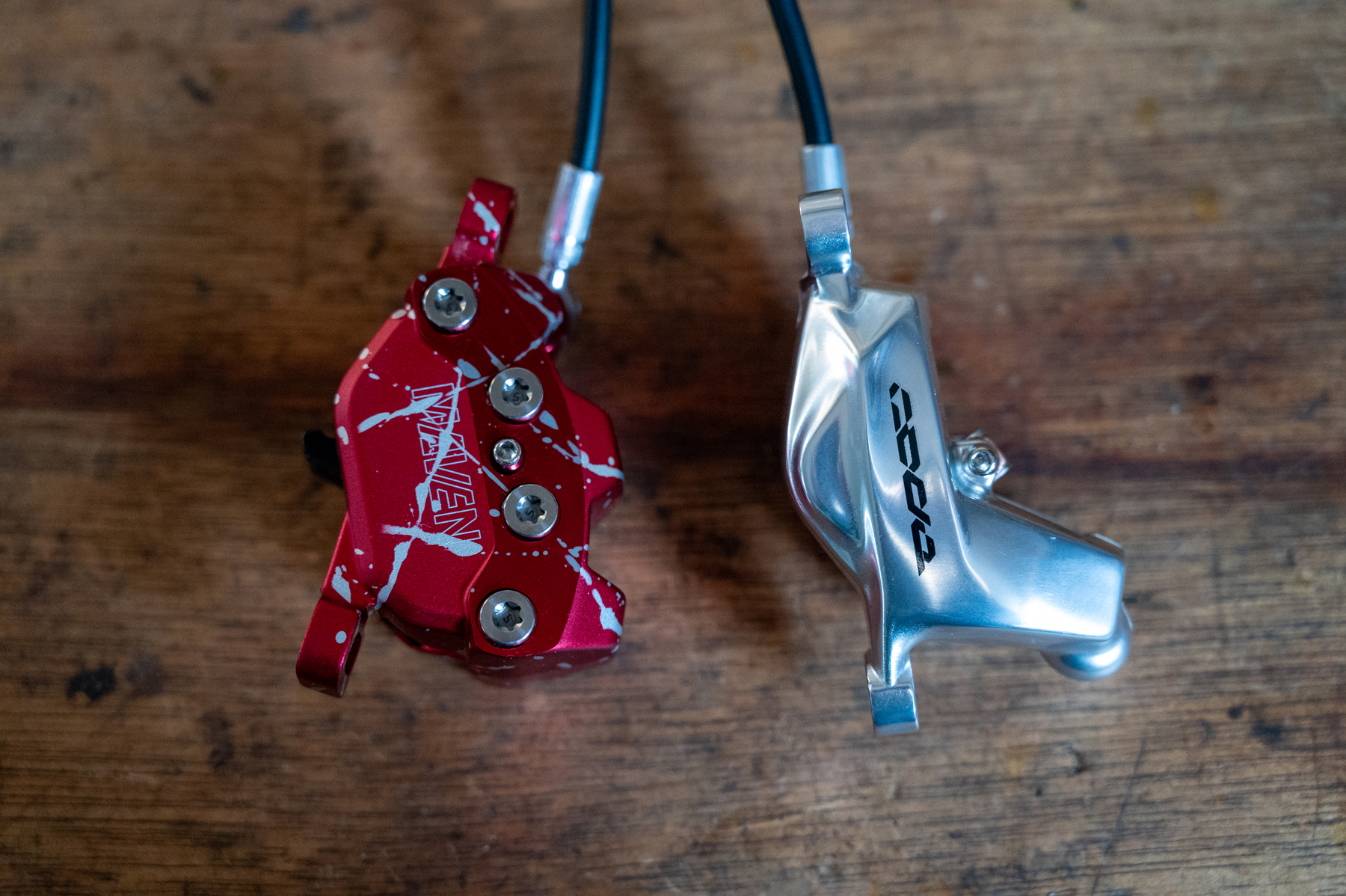
Maven Pads
SRAM has introduced a new pad shape for the Maven calipers which, unsurprisingly, is also a lot bigger than the longstanding Code ones. The new and creatively named “XL” pads are offered in the same organic and sintered metallic material options as the Code ones, but are much larger both in terms of the pad material itself and the backing plate. The four-bolt caliper design also means that the pads have room to load from the bottom only, in contrast to the top-loading Code design.
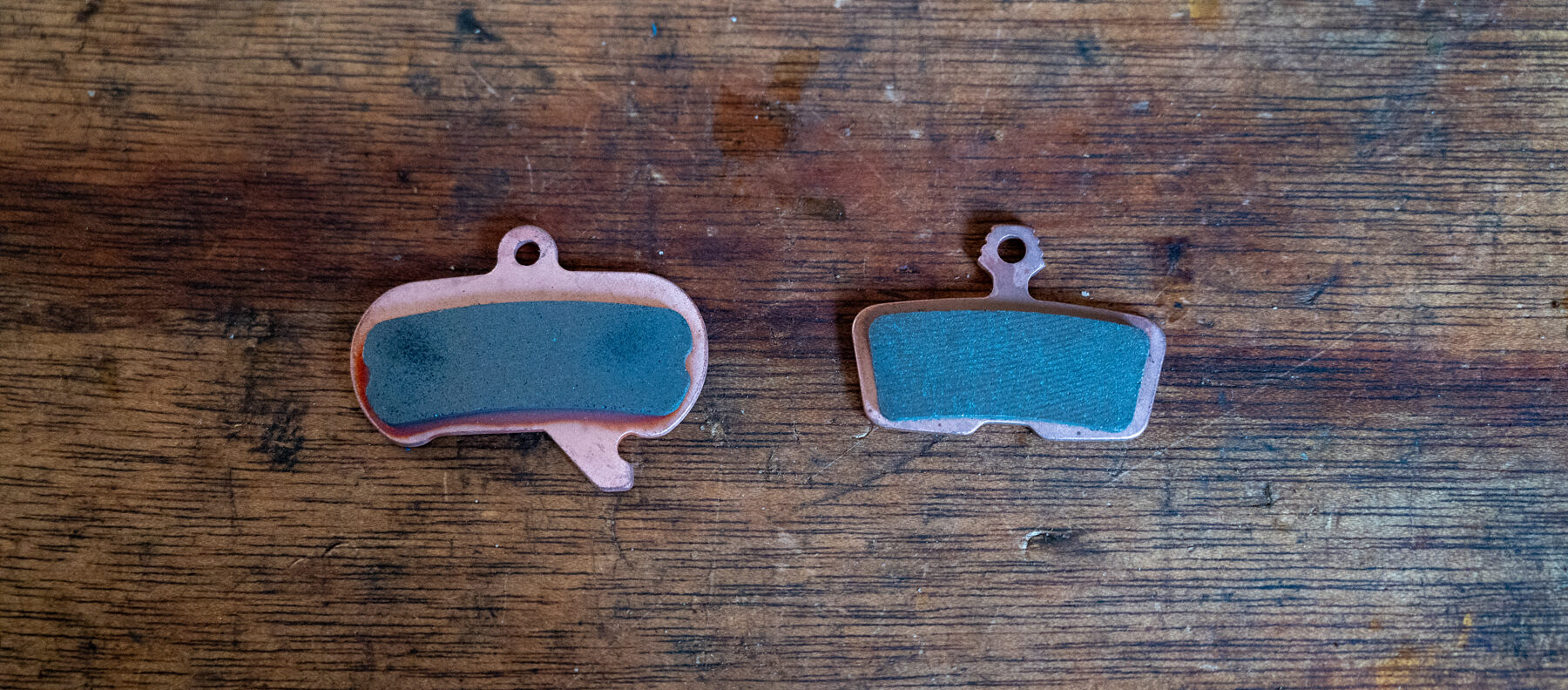
The Maven brakes come stock with organic pads installed, and SRAM says that part of why they gave the Mavens such a big increase in power over Codes was to open up more headroom for folks to tune the brakes’ performance via pad compounds and rotor sizes. There may not be that many people who need 50% more power than Codes when paired with 220 mm rotors and metal pads, but the idea is that some folks who were setting up their Codes to eke maximum power out of them will be able to dial things back a bit with Mavens and end up with a brake that feels better, works more consistently (e.g., it takes some doing to get 220 mm rotors & metal pads up to temp), and is potentially easier to control.
Bleed Process, Adapters, Etc.
The Maven calipers use a version of SRAM’s excellent Bleeding Edge bleed fittings, but they’ve increased the size of the hex broach in the fittings to 5 mm (from 4 mm on Codes) to keep folks from accidentally mixing DOT and mineral-oil fittings and then contaminating the brakes.
The Maven’s bleed process is by and large the same as the Code’s, apart from the change in fluid type. The biggest change is that SRAM has added a final “piston massage” step at the end of the procedure to make sure they’re moving evenly. Essentially, this consists of extending the pistons with the pad spacer installed, then using it to push them back in slightly and repeating; full instructions are on their website.
SRAM has also introduced two new brake adapters for the Maven, with the 20P-1 going from a 160 mm post mount to a 180 mm rotor, and the 20P-2 being designed for a 180 mm mount to a 200 mm rotor, or a 200 mm mount to a 220 mm one. Both use four mounting bolts, with separate ones for mounting the caliper to the frame or fork and for mounting the caliper to the adapter. This is in contrast to SRAM’s older two-bolt mounts with spherical washers under the bolt heads, which aren’t compatible with Mavens, due to clearance issues. I’ve long preferred the four-bolt-style adapters since they’re often easier to align and work on, so this change is a welcome one in my book. SRAM’s existing +40 mm post-mount adapter and their various IS-to-post-mount offerings still work on the Mavens.
Despite the fluid change from DOT to mineral oil, the Maven brakes use standard SRAM hoses and brake fittings, though you shouldn’t use a hose that has previously been used with DOT fluid on the Mavens, or vice versa.
Maven Versions / Models
As with the recently updated Code Stealth brakes, SRAM offers the Mavens in three tiers, each with slightly different features. All use the same basic architecture, pads, etc., but the exact details vary a bit.
The top-tier Maven Ultimate brake’s feature set mostly mirrors that of the Code Ultimate, apart from the Maven Ultimate using a forged aluminum lever blade instead of a carbon fiber one. The Maven Ultimate has tool-free reach and pad-contact adjusters and titanium hardware throughout. Its levers get a clear anodized finish and the calipers have machined aluminum accents to match.
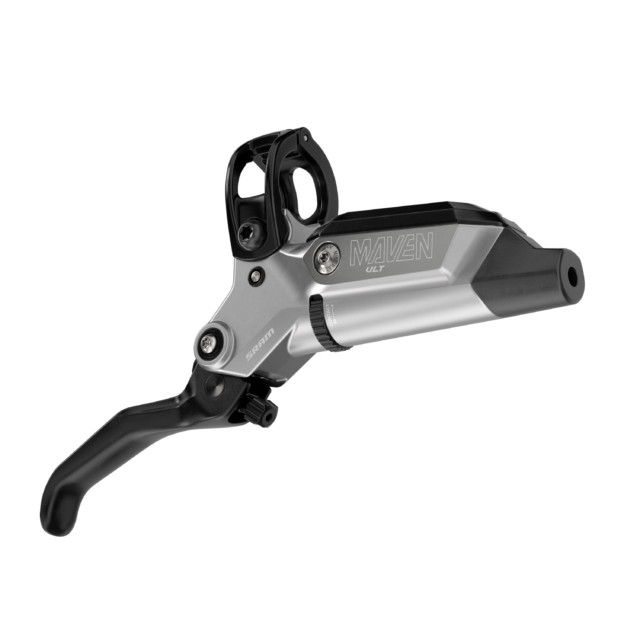
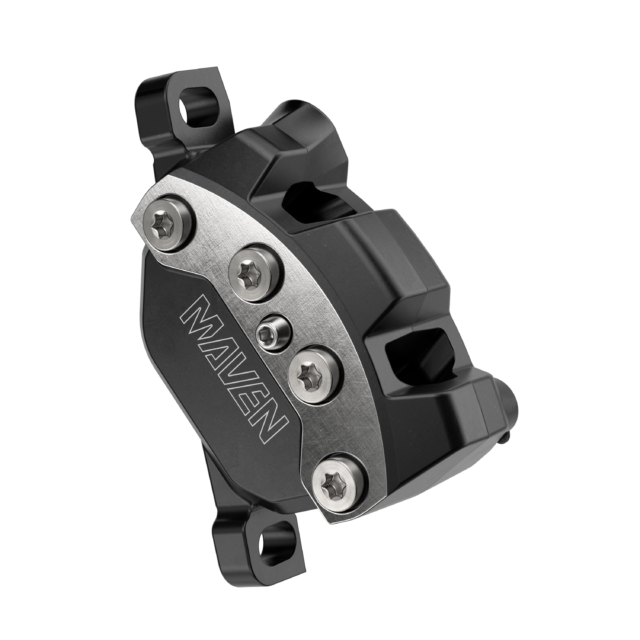
The Maven Silver uses stainless steel hardware in place of the titanium bits on the Ultimate, and the Maven Silver (ironically) gets a black anodized finish instead of the clear one, but keeps the rest of its features. The Silver’s hardware change adds a claimed 9 grams per brake as compared to the Ultimate version.
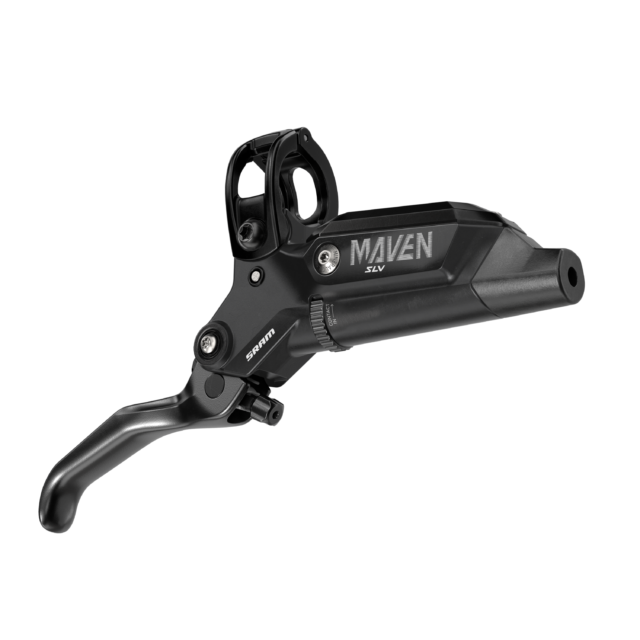

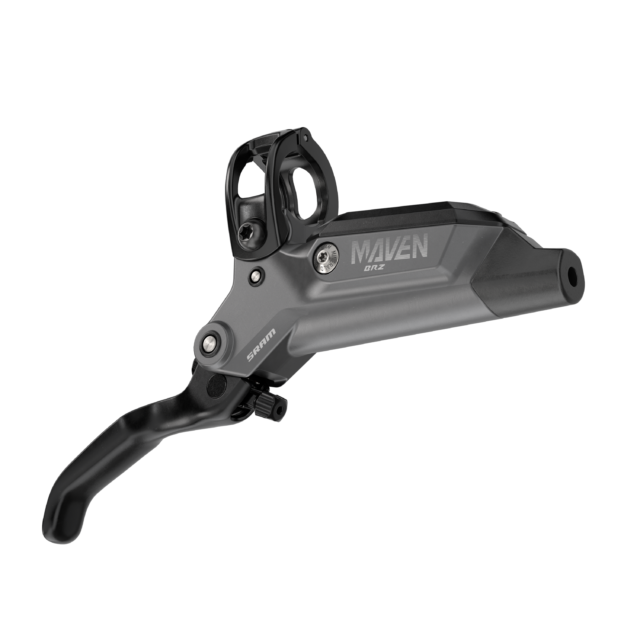
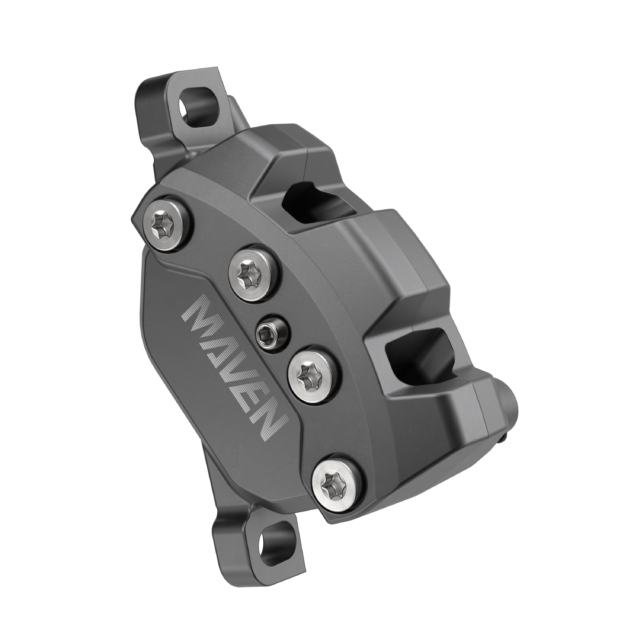

Some Questions / Things We’re Curious About
(1) SRAM Codes are admittedly not the most powerful brakes out there these days, but they’re still viable DH brakes; given that, the Maven’s claimed 50% increase in power seems enormous. Do the Mavens really feel that dramatically more powerful than Codes? And where does that put them relative to the other contenders for the most powerful brakes on the market?
(2) What about lever feel and modulation? SRAM claims the Mavens feel very similar to Codes ergonomically, but how close have they really gotten in that respect?
(3) And how are the Mavens to live with from the standpoint of ease of maintenance, reliability, and so on? SRAM isn’t new to making mineral-oil brakes, having dipped their toe in with the DB8s, but are their claims of extended service intervals borne out? And how hard is it to complete a good bleed on the Mavens?

FULL REVIEW
SRAM’s longstanding Code brakes have a well-earned reputation for reliable, consistent performance, and while they’re powerful enough for a lot of folks to still happily run them on DH bikes, they’re no longer all that close to the top of the heap when it comes to outright power.
[The Stealth versions of the Code brakes that SRAM launched last year are technically new-ish, but they’re more a cosmetic repackaging, and theiir performance is nearly indistinguishable from the prior-generation ones.]
The new Maven brakes are SRAM’s answer for the folks who wanted a burlier option — promising a frankly wild 50% power increase over Codes — so we were curious to see how the Mavens would perform, how usable that much power would feel, and if the Mavens could match the consistency and reliability of Codes.
Having now spent nearly six months on the Maven Ultimates, I’m ready to weigh in — and the Mavens came with a few surprises that have me reconsidering some of my longstanding opinions on brake design.

On the Trail
We’ll start with the easy part: the Mavens indeed offer an immense increase in power over Codes. I can’t claim to be well-calibrated enough to assess whether they’re truly 50% more powerful, exactly, but it seems entirely plausible. And while we haven’t yet been able to directly A-B the Mavens against some of the other most powerful brakes on the market using the same control pads as we did for our big MTB Brake Shootout (the Galfer Pro pads that we used for that test aren’t yet available in the XL Maven shape), I’m confident in saying that the Mavens come out ahead of the Hope Tech 4 V4s that lead that test in terms of outright power by some margin.
Massive power is great, but only if it’s consistent, predictable, and controllable. Going into my testing, I was curious to see if the Mavens would present any issues on those fronts. Would their huge power feel tough to modulate? Would wringing that much power out of a brake have drawbacks in terms of lever feel or consistency?
SRAM says that they aimed to make the lever feel on the Mavens as similar to Codes as they could, and they got impressively close. If there’s any difference in lever blade shape it’s slight enough that I haven’t noticed, but that’s the easy part. Making a brake more powerful means increasing the amount of leverage it provides (between the combined mechanical leverage of the lever assembly itself, and the hydraulic leverage generated by the relative sizes of the master cylinder and the caliper pistons). More leverage means a longer stroke and a softer bite point unless you do some trickery to counteract those changes — and SRAM has done so quite effectively.
Like the Code, the Maven’s free stroke isn’t as light as some of the category leaders (Hayes Dominions) but the Maven Ultimate can be set up with an impressively short free stroke and crisp bite point with the contact point adjustment wound all the way in; backing it off both lengthens the free stroke and softens the bite point a touch.

And that brings me to the first big surprise (for me) of the Mavens: I actually run the contact point adjuster on them wound out a bit (i.e., with the free stroke set longer than the minimum setting). I’ve mentioned before that I don’t usually find contact point adjusters to be all that valuable, because (most of them, anyway) don’t fundamentally change the leverage of the brake or the way that it works, fundamentally — they just make a little bit of dead stroke at the beginning of the lever throw before the brake starts to do anything.
But, for reasons that aren’t quite clear to me, winding out the adjuster on the Mavens also makes the early part of the free stroke appreciably lighter, which I prefer. When I started spending time on the Mavens, I defaulted to running the adjuster wound all the way in, and found the early part of the stroke to feel firmer than I’d like. It wasn’t a huge deal, but especially after getting used to the ultra-light free stroke of the Hope Tech 4 V4s and (especially) Hayes Dominion A4 / T4s, the stiffer-feeling Maven lever felt a bit harder to modulate, and a bit more fatiguing on really extended steep descents that require a lot of brake dragging than I wanted.
But late in what wound up being a ~10,000’ elevation day on the bike, suffering from some arm pump, I tried winding the adjuster out to see if that would help any, and to my surprise, the free stroke felt lighter — and at least for my taste, better. It’s not entirely obvious why that would be mechanically, but I’ll take it. My one real gripe with the Mavens — the stiff-feeling lever — was solved.
The Maven’s free stroke still isn’t as light as that of the V4s or Dominions, but backing off the contact point adjuster took it from being a notable shortcoming (at least for my preferences) to a place that I’m totally happy with. I’d love to be able to have the ultra-short free stroke that the Maven offers with the bite point adjuster wound out and the lighter feel you get with it moved in. But (as we’ve talked about repeatedly, including in our deep dive on brake design with Hope engineer Sam Gibbs), many desirable traits for a brake exist in tension with each other and require the engineers to balance tradeoffs rather than just being able to fully optimize every single individual attribute. SRAM has walked that tightrope impressively well.

One minor downside of the new Stealth lever arrangement that SRAM is using on their current-generation brakes is that it leaves a bit less room to run a standalone clamp for other controls inboard of the brake lever clamp for folks who prefer to do so. I’ve been able to squeeze a few different options in if they’re butted up right against the brake lever, but the reservoir cover quickly gets in the way if you want to push the control clamp farther inboard from there. On the plus side, the hose arrangement on the Mavens (where the hose exits parallel to the bar, rather than angled in toward it on the Code and Level Stealth) has taken care of the issues I’ve run into on those brakes with the hoses rubbing / rattling against the handlebar, which is welcome.
Rotor Sizes & Brake Pads
One of SRAM’s big claims about the Mavens is that they wanted to make them super powerful to give folks more wiggle room to fine-tune their braking performance with rotor sizes and pad compounds, rather than needing to default to big rotors and metal pads to get enough power — and I think they’ve got a point, to a point.
I haven’t been particularly tempted to bump up to a 220 mm front rotor with the Mavens, making them the first brake I can say that about for more gravity-oriented applications. Their power is truly immense. And unlike Codes, where I find the increased power and heat management of SRAM’s metallic pads to be more or less mandatory for use on bigger Enduro and DH bikes, the added power of the Mavens makes SRAM’s organic pads a viable option.
The two pad materials still have their tradeoffs, of course. The metallic pads offer a stronger initial bite (potentially for better or worse depending on your preferences) and more resistance to fading as they get truly hot. The organic pads are easier to get up to operating temperature, especially in colder weather and don’t bite as sharply from the start which some folks will definitely find easier to modulate, but are less consistent in their performance when wet, and are easier to get to fade on really long, sustained descents. I’ve never felt like I came at all close to cooking the Mavens with the metallic pads installed; I’ve gotten the rear brake to start to fade a bit with the organic ones, but it takes a full pull on a steep, sustained descent at pace to do it (think 1,500+ feet of elevation at a rate of 1,000+ feet per mile). And I’ve only gotten a modest dropoff in power, not anything close to a full, catastrophic torching.

That’s all with 200 mm HS2 rotors at both ends, which is the configuration I used for the bulk of my time on the Mavens. I briefly ran a 180 mm rear rotor early in my testing (on the Chromag Lowdown) but eventually moved the Mavens over to the Rocky Mountain Altitude (Full Review coming very soon), which has a 200 mm rotor mount that forced me to size up. I didn’t really need more power from the rear end than I was getting out of the 180 mm rotor, but the 200 mm rear one made the organic pads feel more useable on really big descents by helping with heat management a bit.
And on that front, I think SRAM has a point about the big, bulky Maven caliper helping to maintain a bit of heat in the brakes in a beneficial way, especially in colder, wetter conditions, and when running the metallic pads. As per usual for fully metallic brake pads (irrespective of brand), the Maven ones take a bit of use to warm up to their optimal temperature, and before that point, they don’t provide full power and can be noisy (again, particularly when it’s cold and wet out). But particularly compared to Codes, I’ve found the Mavens to take longer to cool off enough for those issues to return between braking events on a given descent once they’re brought up to temperature in the first place. If it’s particularly cold and wet out, it’s easy to lose sufficient heat in a metallic-pad-equipped Code just between corners, given a bit of a straight section where you’re off the brakes; I haven’t had the same experience with the Mavens.
I think making the Mavens powerful enough that I haven’t wanted to go to super huge rotors helps there, too. Bigger rotors, of course, increase power and can absorb and dissipate more heat without overheating than smaller ones (all else being equal). But that can be a double-edged sword — bigger rotors tend to be a lot harder to get up to temperature in conditions where doing so is challenging, and (big surprise number two) I haven’t found the extra mass of the Maven caliper and pads to make them harder to warm up than Codes. If anything, the fact that I’m happy running smaller rotors on the Mavens means they might actually be quicker to get up to temperature, and they definitely stay there better once they get there in the first place.

So, all told, I still prefer to run metallic pads and 200 mm rotors on both ends of the Mavens — maybe a rotor size down (especially in the front) from where I’d be with Codes on a lot of bikes, but not a total sea change there. The Mavens are sufficiently powerful and (mostly) manage heat well enough for the organic pads to be viable for me in a way that they aren’t really on Codes, but the better wet weather performance, increased durability, and increased resistance to fading of the metallic pads still win the day. And, if anything, the fact that the Mavens hold heat better than Codes reduces the biggest downside of metallic pads in cooler conditions for me — the Mavens do an impressive job of remaining consistent between braking events, I think mostly because of their reduced temperature swings.
Maintenance
I’ve been on the same set of Mavens since mid-winter, and they’ve been quite consistent and reliable in their performance, and otherwise pretty easy to live with. The fact that they use the same fittings as most of SRAM’s other brakes (despite the swap to mineral oil) is welcome, their fluid volume is sufficient to stop the lever feel from changing much as the pads wear down, and while a new pad shape isn’t ideal, the bigger Maven caliper and the added pad area it allows easily justifies its existence in my book.
I did have a hard time getting a fully perfect bleed on the Mavens at first, though. I’d followed SRAM’s instructions, including performing the “piston massage” step and everything seemed solid in the shop… but then I’d go for a ride and experience a little hint of inconsistency in the bite point of the brakes (more so the rear than the front). It wasn’t dramatic — nothing close to a Shimano brake that’s fully given up the ghost — but the bite point would move in very slightly when I took a first stab at the brakes after being off them for a bit, then pump back out with a squeeze or two.
But after a couple of rides and a couple of rounds of bleeding, I got to a point where the Mavens felt completely consistent, and they haven’t wavered since. My hunch is that I simply had a little bubble or two trapped somewhere that took a little while to work free. I also haven’t needed to re-bleed them when swapping pads, and have found their total fluid volume to be able to handle quite-worn pads without major changes to the lever feel (though I admittedly haven’t pushed my luck too super far on that front).
It’s also worth noting that the piston retraction on the Mavens is notably good for a super-powerful brake, especially one that manages to have a fairly short free stroke, too. It’s a delicate balancing act to trade off power (i.e., leverage) with lever feel and pad-to-rotor clearance, but SRAM has done a notably good job there.
As a final minor note, I’m also a big fan of the new +20 mm adapters that the bulkier Maven caliper necessitated. SRAM is hardly the only brand to move to this style, but using separate bolts to attach the adapter to the fork / frame and the caliper to the adapter makes dialing in alignment of the brake a lot easier than the two-bolt style with spherical washers between the caliper and bolt heads, and the few extra grams of the four-bolt style are easily worth the improved ease of use in my book.

Bottom Line
The SRAM Maven is the most powerful mountain bike brake I’ve ridden to date, but they’re not just a Code with gobs more power. The way that the Mavens manage heat (both in avoiding overheating, but especially in maintaining an appropriate temperature to work well) is fantastic, and has let me run smaller rotors than I would on bigger Enduro / DH bikes with most other brakes — to surprising effect. The Mavens are notably heavy (that stellar heat management takes some mass to achieve) but brakes are just about the last place I’d go looking for weight savings on the sorts of bikes the Mavens are meant for.
And by putting weight concerns to the side, SRAM has made a mega-powerful, impressively consistent brake that somehow also has better-than-average piston retraction (i.e., pad-to-rotor clearance) and a surprisingly short free stroke if you wind the contact point adjuster in. I’d love it if the free stroke was a little lighter (mostly with the free stroke set at the short end of its range; backing it off helps a lot there) and bleeding the Mavens could be a little easier but those are pretty minor downsides on what is, overall, a truly stellar brake.

Great review as always. Think you’ll add the Mavens to the Brake shootout spectrums or is the juice not worth the squeeze at this point? Also, I’ve been curious for a while how exactly these four-bolt rotor adaptors allow for easier alignment than the two-bolt type with cup and cone washers. Does the 4-bolt type still allow you to losen the screws and slightly move the caliper to eliminate rotor rub? Or is the benefit that by having the four bolts and tightening down, the caliper will be aligned and can’t be moved out of alignment?
Yup, we’ll have an update to the shootout in a bit with the Mavens and a couple more newer things too. Stay tuned…
The biggest advantage of the four bolt adapters is that the caliper is less prone to moving while you’re tightening the bolts down. The spherical washers tend to apply clamping force somewhat unevenly and in doing so they push the caliper inboard as you’re tightening it down.
Aha! That makes sense. I guess I’ve been thinking about the movement of cup and cone washers as a feature, but really it’s a bug. I guess if you’re experiencing rotor rub when using the 4 bolt style adaptors, you should probably fix the root cause like a bent rotor or pistons not firing evenly, rather than thinking the caliper isn’t centered.
I’m a long time shimano xt two-piston brake user and have finally gotten fed up with their wandering bite point and am now ready to check out other companies’ offerings. Your review has me very interested to try the mavens. My only wish is that the pads were top loading!
David! Congrats for super detailed review
But you can say little more about bleed process? Because i am having some issue…
In shop all good, but when go to trail, inconsistency in the bite point begins
I got one to replace the code in the front of my bike. I wished for more brake force with less lever force, especially on longer descents where my left hand would get fairly tired.
At the same time, I didn’t want to go to a 220 mm rotor up front, due to concerns about bending and warping, but more importantly because I live in the Midwest. Riding at home, our brakes never get much time to warm up, and the front rotor doesn’t heat up much anyways. So I’d rather have a stronger brake and the same rotor, so that it gets up to a good temp quickly.
Running the mis-matched set feels very normal, and similar to my hands.
I know Magura used to offer a set like this.